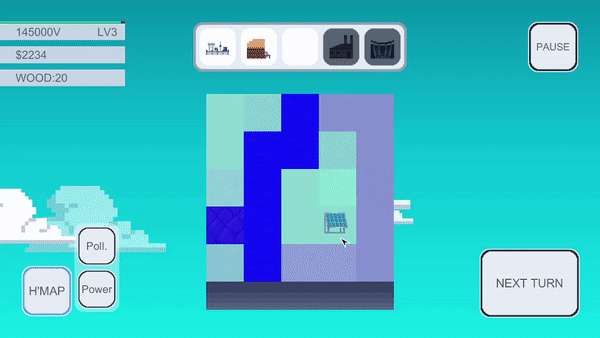Aidan McHugh, Gamedev @ Coatsink.
Micropolis
An artefact designed for a course module to show prowess in UI, UX and complex systems.

-
A prototype created in Unity, a free and open-source game engine.
- Developed for a third year university module.
-
C# was used for various coded elements in the game.
-
I also created all visual assets in-game.
-
Single person project lasting roughly three months, from September 20th to December 15th.
Project Overview
Micropolis was developed for a module focused around showcasing individual talents in game development. For my artefact, I settled on a simulator/city builder game to show my ability to design UI that simplifies complex mechanics to make games easily understandable to newcomers. This included creating a lightweight system that could handle multiple objects interacting with one another on a fixed basis, a UI system to help organize concepts such as in-game grid pollution and power into visual feedback through heatmaps, and designing the user experience to be as user friendly as possible through tutorials in a genre notorious for complexity.
Project Challenges
-
This was the first solo module in university where the artefact brief was based solely on the developer's ideas, not a third party. This meant managing our own projects to match our own briefs.
-
As complex systems were a large focus, a large amount of development was spent focusing on making the grid system as bug free as possible.
-
The tutorial system and UI were continously improved through multiple playtesting sessions, and required extra UI assets to clarify what the goal of the game was.
-
The Milestone mechanic, giving feedback to the player on their achievements and shortcomings, required extra attention so that the data structure was easy to edit and modify, and so that Milestones would appear correctly in gameplay.
Feedback
When reviewed by the head lecturer of my degree's course, he praised the attention to player understanding, and said the artefact was approaching the standard required in the incredibly competitive mobile puzzle-saga market, especially with the game's highly polished art. The UI was also received well, with positive remarks on screen space usage and interaction. However, it was noted that whilst the code was suitably complex, a standout complex system would have been needed for higher marks.
For this section of the module, I received a mark of 71% for the coding, contributing to a 70% grade for the module overall.


